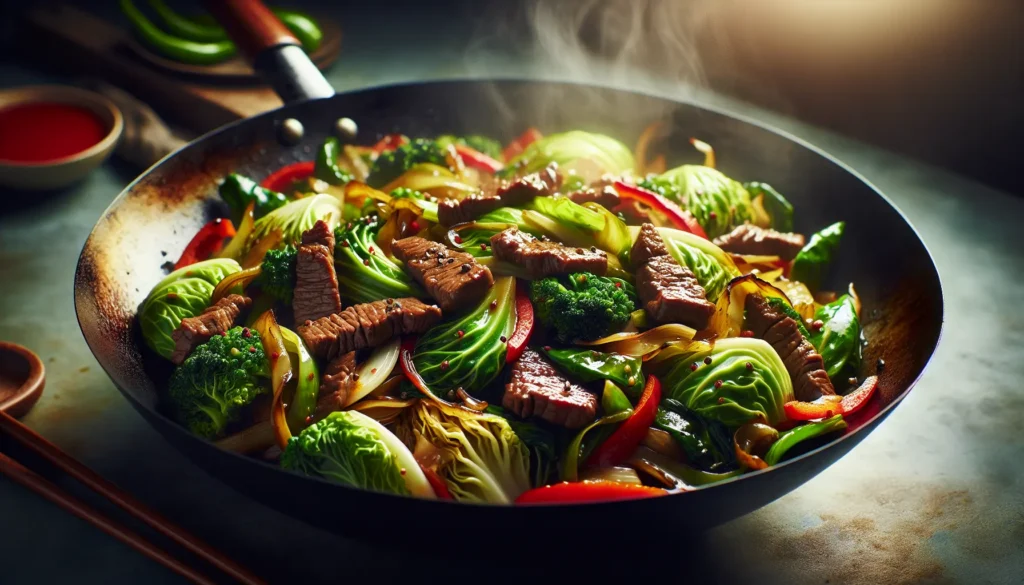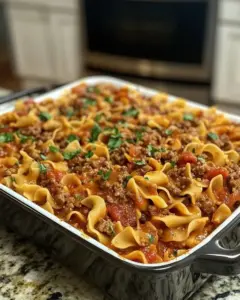Last Updated on 08/02/2025 by SAVORY DELIGHT RECIPES LLC
In the realm of quick and satisfying meals, cabbage and beef stir fry stands out as a true champion. This savory dish combines tender strips of sirloin steak with crisp cabbage in a flavorful black pepper sauce, creating a harmonious blend of textures and tastes. Perfect for busy weeknights, this one-pan meal not only saves time but also delivers a nutrient-packed dinner that the whole family will enjoy.
As we delve into the world of stir-frying, we’ll explore the essential ingredients and techniques to create this delectable dish. From selecting the right cut of beef to preparing the perfect stir-fry sauce, this guide will walk you through each step of the process. We’ll also discuss how to achieve the ideal balance of flavors using sesame oil, garlic, and scallions, and share tips for getting that restaurant-quality wok hei in your own kitchen. By the end, you’ll be equipped with the knowledge to whip up a mouthwatering cabbage and beef stir fry that’s sure to become a regular in your meal rotation.
Ingredients You’ll Need
To create a delicious cabbage and beef stir fry, it’s essential to gather the right ingredients. This savory dish combines tender beef with crisp vegetables and a flavorful sauce, resulting in a satisfying meal that’s perfect for busy weeknights. Let’s break down the ingredients into two categories: essential components and optional add-ins that can enhance the dish’s flavor and nutritional value.
Essential Ingredients
- Beef: The star of this dish is the beef. For the best results, choose a cut that’s well-suited for stir-frying. Sirloin steak is an excellent option, as it’s flavorful and tender when cooked quickly over high heat. Alternatively, you can use flank steak or even ground beef for a budget-friendly version.
- Cabbage: Green cabbage is the go-to choice for this stir fry. It’s readily available, affordable, and holds up well to high-heat cooking. When sliced thinly, it becomes tender and absorbs the flavors of the sauce beautifully.
- onion: A medium-sized onion adds depth and sweetness to the dish. You can use white, yellow, or red onions, depending on your preference.
- Garlic and Ginger: These aromatic ingredients are crucial for creating an authentic Asian-inspired flavor profile. Fresh minced garlic and grated ginger work best, but pre-minced options can save time in a pinch.
- Vegetable Oil: Use a neutral-flavored oil with a high smoke point, such as avocado or safflower oil, for stir-frying.
- Soy Sauce: This umami-rich condiment forms the base of the stir-fry sauce. Opt for low-sodium soy sauce to control the salt content.
- Cornstarch: A small amount of cornstarch helps thicken the sauce, allowing it to coat the beef and vegetables evenly.
- black pepper: Freshly ground black pepper adds a spicy kick and complements the beef beautifully.
- Sesame Oil: A drizzle of toasted sesame oil at the end of cooking imparts a nutty aroma and authentic Asian flavor.
Optional Add-ins
- Vegetables: While cabbage is the main vegetable in this dish, you can add variety and nutrition by including other veggies. Sliced carrots, bell peppers (red, green, or yellow), or mushrooms are great options that complement the beef and cabbage.
- Rice Wine or Dry Sherry: A splash of Chinese rice wine or dry sherry can add depth to the sauce. If you don’t have these on hand, you can substitute with a bit of rice vinegar or simply omit it.
- Oyster Sauce: This thick, savory sauce can enhance the umami flavor of the dish. Use it sparingly, as it’s quite potent.
- Chili Garlic Sauce or Red Pepper Flakes: For those who enjoy a bit of heat, adding these spicy elements can kick the flavor up a notch.
- Scallions: Thinly sliced green onions make a great garnish, adding a fresh, oniony bite to the finished dish.
- Sesame Seeds: Toasted sesame seeds sprinkled on top not only add visual appeal but also contribute a pleasant crunch and nutty flavor.
- Beef Stock: A small amount of beef stock can help create a richer sauce, especially if you’re using leaner cuts of beef.
By gathering these ingredients, you’ll be well-prepared to create a mouthwatering cabbage and beef stir fry. Remember, the key to a great stir fry is having all your ingredients prepped and ready before you start cooking, as the actual cooking process happens quickly over high heat.
Preparing the Beef and Vegetables
Proper preparation of ingredients is crucial for a successful cabbage and beef stir fry. This step ensures that all components cook evenly and quickly, resulting in a delicious one-pan meal. Let’s break down the process into three main parts: slicing the beef, chopping the cabbage, and preparing other vegetables.
Slicing the Beef
For a tender and flavorful stir fry, selecting the right cut of beef is essential. Flank steak, sirloin steak, or even ground beef can work well in this savory dish. If using a whole cut of beef, it’s important to slice it correctly:
- Partially freeze the beef for 30 to 60 minutes until firm. This makes it easier to slice thinly.
- Identify the grain of the meat (the direction of the muscle fibers).
- Cut against the grain into thin strips, about 1/4 inch thick. This helps tenderize the meat.
- If using ground beef, simply break it up with a spatula while cooking.
After slicing, marinate the beef to enhance its flavor and texture. Mix it with a combination of soy sauce, cornstarch, and a little vegetable oil. This process, known as velveting, gives the beef a smooth, tender texture when cooked. Let it marinate for 15-30 minutes while preparing the vegetables.
Chopping the Cabbage
Cabbage is the star vegetable in this stir fry, and proper preparation ensures it cooks evenly and absorbs the flavors of the dish:
- Remove any tough outer leaves and rinse the cabbage.
- Cut the cabbage in half through the core.
- Remove the core by cutting diagonally along its base.
- Slice the cabbage into thin strips, about 1/4 to 1/2 inch wide.
For a quicker option, you can use pre-shredded coleslaw mix as a substitute for fresh cabbage. This saves time without compromising on flavor or texture.
Preparing Other Vegetables
Adding a variety of vegetables not only enhances the nutritional value of your stir fry but also creates a more colorful and appetizing dish. Here are some popular additions and how to prepare them:
- Carrots: Peel and julienne or cut into thin diagonal slices.
- Bell peppers: Remove seeds and slice into thin strips.
- Onions: Slice thinly or chop into small pieces.
- Garlic and ginger: Mince finely for maximum flavor distribution.
- Scallions: Slice thinly, separating the white and green parts.
Other vegetables that work well in a cabbage and beef stir fry include sliced mushrooms, snow peas, broccoli florets, and water chestnuts. Feel free to experiment with your favorite combinations.
Remember to cut all vegetables into similar-sized pieces to ensure even cooking. Having all ingredients prepped and ready before you start cooking is crucial, as stir-frying is a quick process that requires immediate access to all components.
By taking the time to properly prepare your beef and vegetables, you’re setting the stage for a delicious and satisfying cabbage and beef stir fry. The next step will be to heat up your wok or large skillet and bring all these elements together in a flavorful, weeknight-friendly meal.
Making the Stir Fry Sauce
The secret to a mouthwatering cabbage and beef stir fry lies in its savory sauce. A well-balanced stir-fry sauce brings all the flavors together, coating the beef and vegetables with a delicious glaze. Let’s explore the key components of a perfect stir-fry sauce and learn how to adjust the flavors to suit your taste.
Key Sauce Components
To create a flavorful stir-fry sauce for your cabbage and beef dish, you’ll need a combination of umami-rich ingredients. Here are the essential components:
- Soy Sauce: This forms the base of the sauce, providing a salty, savory flavor. Use low-sodium soy sauce to control the salt content. For a deeper color and flavor, you can replace a tablespoon of regular soy sauce with dark soy sauce.
- Oyster Sauce: This thick, flavorful sauce adds complexity and depth to the stir fry. If you don’t have oyster sauce, you can substitute it with hoisin sauce.
- Chinese Rice Wine: Also known as Shaoxing wine, this ingredient adds a subtle depth of flavor. If unavailable, you can use dry sherry, mirin, or cooking sake as alternatives. For a non-alcoholic option, substitute with chicken or vegetable broth.
- Beef Stock: Using stock instead of water enhances the overall flavor of the sauce. Opt for low-sodium or no-salt-added stock to keep the saltiness in check.
- Cornstarch: This thickening agent helps create a glossy, coat-able sauce that clings to the beef and vegetables.
- Sesame Oil: A small amount of this aromatic oil adds a nutty, toasty flavor to the sauce. Remember, a little goes a long way!
- Rice Vinegar: This mild vinegar adds a subtle tang and balances the flavors. Start with a small amount and adjust to taste.
- Sugar or Honey: A touch of sweetness helps balance the salty and tangy elements in the sauce.
- Black Pepper: Freshly ground black pepper is crucial for this dish, as it’s a key flavor component in the sauce.
To make the sauce, simply combine all these ingredients in a small bowl or jug. Mix them thoroughly to ensure the cornstarch is fully dissolved and there are no lumps.
Adjusting Flavors
One of the advantages of making your own stir-fry sauce is the ability to customize it to your liking. Here are some tips for adjusting the flavors:
- Sweetness: If you prefer a sweeter sauce, add an extra teaspoon of sugar or honey. Brown sugar can be used for a deeper, molasses-like sweetness.
- Tanginess: To increase the sour notes, add more rice vinegar, starting with an extra half teaspoon.
- Saltiness: The soy sauce and oyster sauce already contribute significant saltiness. If you need more, add a pinch of salt rather than extra soy sauce to avoid overpowering other flavors.
- Heat: For a spicy kick, add a pinch of red pepper flakes or a small amount of chili garlic paste.
- Thickness: If you want a thicker sauce, increase the cornstarch by up to an additional tablespoon. For a thinner sauce, add a splash of water or extra broth.
- Umami: To boost the savory flavors, add an extra teaspoon of oyster sauce or a splash more soy sauce.
Remember to taste and adjust the sauce before adding it to your stir fry. Keep in mind that the flavors will intensify slightly as the sauce reduces during cooking.
When it’s time to add the sauce to your cabbage and beef stir fry, pour it into the wok or pan after the beef and vegetables are mostly cooked. Let it simmer gently, stirring constantly, until it thickens and coats the ingredients evenly. This process usually takes about 1-2 minutes.
By mastering the art of making a delicious stir-fry sauce, you’ll elevate your cabbage and beef stir fry from a simple weeknight meal to a restaurant-quality dish bursting with flavor.
Cooking the Stir Fry
Stir Frying the Beef
The key to a delicious cabbage and beef stir fry lies in properly cooking the beef. Start by heating your wok or large skillet over medium-high heat. Once it’s hot, add about two tablespoons of vegetable oil, swirling it around to coat the surface. This technique, known as “longyau” or “huaguo,” creates a slippery frying surface that prevents sticking.
When the oil is shimmering, it’s time to add the marinated beef. If you’re using sirloin steak, make sure it’s sliced against the grain into thin strips. For those opting for ground beef, it works just as well in this savory dish. Spread the beef in an even layer and let it sear for about 30 seconds before stirring. This initial sear helps lock in the juices and creates a flavorful crust.
Continue to stir-fry the beef for about 1-2 minutes until it’s about 80-90% cooked. The meat should have a nice brown color but still be slightly pink in the center. Once done, remove the beef from the wok and set it aside. This step ensures that the beef doesn’t overcook while you prepare the vegetables.
Adding the Vegetables
With the beef set aside, it’s time to focus on the star of this dish – the cabbage. Add another tablespoon of oil to the wok if needed, then toss in your aromatics. Minced garlic and ginger work wonderfully to enhance the flavors of this one-pan meal. Stir-fry these for about 15-20 seconds until fragrant.
Next, add your sliced cabbage to the wok. If you’re using other vegetables like carrots or red bell peppers, now’s the time to add them as well. Stir-fry the vegetables over high heat, tossing them frequently to ensure even cooking. The goal is to have the cabbage slightly wilted but still crisp, which usually takes about 2-3 minutes.
Incorporating the Sauce
Now comes the exciting part – bringing all the flavors together with a delicious stir-fry sauce. If you’ve prepared a sauce beforehand, this is the moment to add it to the wok. For a simple yet flavorful sauce, you can use a combination of soy sauce, oyster sauce, and a touch of sesame oil.
Pour the sauce around the sides of the wok rather than directly onto the vegetables. This technique allows the sauce to heat up quickly and creates a nice sizzle. Toss everything together, making sure the vegetables are evenly coated with the sauce.
At this point, add the cooked beef back into the wok. Stir everything together, allowing the beef to reheat and absorb some of the sauce. If you’re using ground beef, make sure to break up any large clumps as you stir.
For a thicker sauce that clings to the ingredients, you can add a cornstarch slurry. Mix a teaspoon of cornstarch with a tablespoon of water and drizzle it into the wok while stirring constantly. The sauce will thicken almost immediately, creating a glossy coating on the beef and cabbage.
Finally, toss in some chopped scallions for a fresh, oniony bite. A sprinkle of sesame seeds can add a nice crunch and nutty flavor to your cabbage and beef stir fry. Give everything a final toss, ensuring all ingredients are well combined and heated through.
Remember, the key to a great stir-fry is quick cooking over high heat. This entire process, from cooking the beef to finishing with the sauce, should take no more than 10-15 minutes. The result is a delicious, savory dish that’s perfect for a quick weeknight dinner.
Serving Suggestions
A delicious cabbage and beef stir fry is a versatile dish that can be enjoyed in various ways. To elevate your meal and create a satisfying dining experience, consider these serving suggestions that complement the savory flavors of this one-pan meal.
Rice and Noodle Pairings
One of the most popular ways to serve this savory dish is over a bed of rice or noodles. These starchy bases not only help to soak up the flavorful stir-fry sauce but also make the meal more filling and satisfying.
For rice options, consider serving your cabbage and beef stir fry with:
• White rice: A classic choice that pairs well with the savory flavors of the dish. • Brown rice: For a healthier alternative with added fiber and nutrients. • Cauliflower rice: A low-carb option that’s perfect for those watching their carbohydrate intake.
If you prefer noodles, try these delicious pairings:
• Rice noodles: These light and delicate noodles absorb the flavors of the stir-fry sauce beautifully. • Lo mein noodles: Their chewy texture adds an interesting contrast to the tender beef and crisp vegetables. • Udon noodles: These thick, chewy noodles are perfect for soaking up the savory sauce. • Spaghetti: In a pinch, regular spaghetti can be a great substitute for Asian-style noodles.
For those looking to keep the meal low-carb, serving the stir fry over zucchini noodles or spaghetti squash is an excellent alternative.
Garnish Ideas
To add a final touch of flavor and visual appeal to your cabbage and beef stir fry, consider these garnish ideas:
• Sesame seeds: Sprinkle toasted sesame seeds over the dish for a nutty crunch and visual interest. • Scallions: Thinly sliced green onions add a fresh, oniony bite and a pop of color. • Lime or lemon wedges: A squeeze of citrus can brighten up the flavors and add a zesty note. • Sriracha sauce: For those who enjoy a spicy kick, a drizzle of sriracha can take the dish to the next level. • Chopped cilantro: This herb adds a fresh, aromatic touch to the dish. • Carrot curls: For added crunch and color, top with some thinly sliced or spiralized carrots. • Crushed peanuts: A sprinkle of crushed peanuts can add texture and a complementary flavor to the dish.
Remember, garnishes not only enhance the flavor but also contribute to the visual appeal of your cabbage and beef stir fry. A well-garnished dish can make your weeknight dinner feel like a restaurant-quality meal.
To round out your meal, consider serving your stir fry with some complementary side dishes. A light soup, like Easy Egg Drop Soup, can be a great starter. For added vegetables, a side of Roasted Frozen Broccoli or Roasted Cauliflower can increase the nutritional value of your meal. A refreshing Thai Cucumber Salad can provide a cool contrast to the warm stir fry.
By experimenting with different rice and noodle pairings, as well as various garnishes and side dishes, you can create endless variations of this versatile cabbage and beef stir fry. This allows you to keep the meal exciting and new, even if you enjoy it regularly as part of your weeknight dinner rotation.
Conclusion
The cabbage and beef stir fry recipe presented here offers a delightful blend of flavors and textures, making it a perfect addition to your weeknight dinner rotation. Its versatility allows for customization with various vegetables and seasonings, catering to different tastes and dietary preferences. The step-by-step guide provides all the necessary information to create a restaurant-quality dish in the comfort of your own kitchen.
This quick and easy meal not only satisfies hunger but also contributes to a balanced diet with its combination of protein-rich beef and nutrient-packed cabbage. The serving suggestions and garnish ideas offer numerous ways to elevate the dish, turning a simple stir fry into a complete and satisfying meal. Whether you’re a seasoned cook or a beginner in the kitchen, this cabbage and beef stir fry recipe is sure to become a go-to option for busy evenings when you want a tasty, nutritious dinner on the table in no time.
FAQs
Should I blanch cabbage before using it in a stir fry?
If you are using cabbages with tougher leaves, such as Savoy cabbage, it can be helpful to blanch the leaves for one minute in boiling water. After blanching, make sure to dry the leaves thoroughly before proceeding with your stir fry.
How can I prevent the beef in my stir fry from becoming chewy?
To tenderize beef, especially cheaper cuts, sprinkle 3/4 teaspoon of baking soda over 250 grams (about 8 ounces) of sliced beef. Mix well with your hands, let it sit for 30 minutes, then rinse and pat dry before using in your stir fry. You can marinate the beef with your choice of seasonings or cook it plain.
Why is Napa cabbage recommended for stir frying?
Napa cabbage is particularly suited for stir fries due to its tender texture and mild flavor, which makes it cook quickly and blend well with other ingredients. In contrast, regular cabbage has a tougher texture, making it more suitable for longer cooking methods.
What is a good method for stir frying tough cuts of beef?
To keep beef moist and tender during stir frying, toss the sliced beef with corn starch before cooking. This technique, inspired by a Chinese method known as velveting, involves marinating the beef in a mixture of corn starch and either cooking wine or soy sauce for about 15 minutes. This helps to seal in moisture and prevent the beef from drying out during cooking.





Comments are closed.